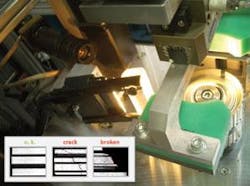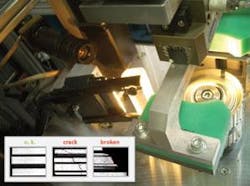Complex Thinking
A discussion with Katrin Pape, CTMV
VSD: Please describe your company and its services.
Pape: CTMV is a solution provider with experience in the field of image processing. Its founders draw on expertise in developing new application areas and complex application scenarios and their implementation in workable business solutions. Applications are focused on surface inspection of visually difficult materials such as glass, ceramics, various metals, plastic tubes, and foils.
In addition, we provide precise dimensional-accuracy verification, mainly for the stamping industry, and on presence/absence checks in applications such as the assembly of gear shafts, as well as position detection of moving and/or complex parts for robots and handling. CTMV offers business solutions for quality assurance in the fields of medicine, electronics, and automotive, as well as for process optimization of manufacturing in the fields of metal working, extrusion, and foil/paper production.
VSD: What technologies and components do you use for your applications? How often do you evaluate competing technologies?
Pape: Depending on the inspection task and its general framework, we use area- or linescan camera technology combined with appropriate standard interfaces based on camera buses or network technology, as well as PC or embedded compact vision systems. We continuously evaluate new products and work in close cooperation with standard component suppliers. The decision on whether new products will finally be implemented in standard applications is based on their specific benefit and on whether they help solve problems in a more reliable, robust, and possibly cost-efficient way.
Application-specific software with straightforward user interfaces and reliable intelligent algorithms for feature extraction and analysis will usually be implemented by CTMV. Developing field-specific analysis software and tools with a minimum set of parameters but a maximum of intelligence and performance is one of our core competencies.
VSD: How do you approach a new application? Do you work with OEMs or other system integrators?
Pape: Conceptual design of new applications is the key intellectual property that distinguishes us from our competitors. With our broad experience basis as a team, we continue to be able to design new approaches and concepts. This starts by determining the appropriate method of image acquisition, as well as highlighting test criteria with the adequate optical and illumination setup. The process includes developing reliable and robust methods for analysis of the image content, and continues to integration into the process chain with adequate signal and data exchange.
Key requirements are usually specified by customers or mechanical engineers. The diversity of customer and field-specific needs—in each case based on a combination of image processing and process engineering—opens up completely new applications. One example is a system for continuous tube inspection during extrusion, with detection and classification of process-related defects combined with special failure management and alerting. Another is quality control of metallic gear wheels during production, detecting scratches, cracks, and broken parts (see figure).
VSD: How do you design your systems for OEM product obsolescence?
Pape: Our safeguard here is working exclusively with industry standards. Components are exchangeable quickly and easily, so our customers get continuous, reliable functionality. We are independent of operating systems because we cooperate with reputable partners such as National Instruments (Austin, TX, USA; www.ni.com). These companies develop and provide system and field-independent standard components that meet industrial camera interface and automation standards.
VSD: What are users demanding from you in the design of new systems?
Pape: The general expectation is the application of modern, open standard technologies. Based on the latest developments on the components market and the way we integrate these trends into our system concepts, we meet these expectations in every respect.
The bigger challenge, however, is the balancing act that is needed to cover the span between the requirements for maximum identification performance—frequently using highly complex methods of analysis—and the simultaneous required ease of use. Examples of this are the stamping industry, as well as packaging and food, or presence/absence checks and version monitoring.
In these cases, the variety of parts to be inspected is high, and operators want to be able to create test plans for modified or new products themselves. This requires robust test cells on the one hand, and on the other hand adaptable software with respective part management and the right balance between parameterization possibilities and hidden advanced functionality.
To meet these requirements, we generally develop customer-specific user interfaces and implement easy-to-use setup and inspection plan editors with a minimum set of algorithms, tailor-made for the respective application or field of industry. We make a point of thinking in and implementing the language of the respective user or application environment and not that of image processing. Based on these key strategies, we provide users with the necessary flexibility without requiring them to have specific knowledge of image processing.
VSD: How will OEM components targeted toward machine-vision applications have to change to meet future needs?
Pape: Scalability and adaptability are required not only for software, but also for system bases. We often encounter the issue that initial specifications are later enhanced, further inspection tasks are added, or solutions have to be adapted to specific customer environments—all while keeping development efforts as low as possible. The ongoing standardization in the field of camera interfaces is an essential step and key factor in this respect. It enables us to meet these requirements today and should definitely be pursued further into the future.
Another key point is that, as a rule, vision systems need to communicate with a complex network of instrumentation, control, and drive systems. The direct combination of industrial interfaces for process communication such as Ethernet, digital I/O, and so forth, with image-processing components is beneficial for us. Application of various modules, including those from different suppliers, can be minimized or might not be necessary at all. This saves time and limits technical risks.
Examples are modules that combine the camera bus with FPGA-based, digital I/O. The camera bus ensures the image acquisition, while the complete timing, trigger handling, and partly complex encoder handling in real time are done by the I/O module. In this way, and with the systems capable of being operated within networks, we can now solve 95% of inspection tasks using area-scan cameras. We would wish for additional, similar technologies—for example, with linescan or network-based camera interfaces (GigE).
VSD: How do you think that the machine-vision market differs in Germany from that in other parts of Europe or North America? What changes have you seen recently in the German market?
Pape: Our customers usually are machinery manufacturers who provide sales and servicing of complete machinery and equipment including optical inspection systems. Machinery incorporating CTMV vision systems has been installed all over North America and Europe. General trends are global. However, in Germany, there is intense competition between suppliers of components and system integrators. On the other hand, mechanical engineers increasingly ask for industrial image processing solutions, identifying these as substantial competitive edge.
In general, we see a market differentiation toward plug-and-play solutions that are easy to configure and will not require system-integrator services in the future. At the same time, some customers are interested in solutions for new, complex inspection tasks that have not been tackled so far. This is where we as CTMV can provide know how.
VSD: What new markets and technologies do you see for CTMV in the future?
Pape: In the next few years, we see continuous opportunities for growth. CTMV will focus on further development of business solutions in medical, electronics, plastics, and automotive markets. And, we will develop new, innovative image-processing solutions within the scope of strategic partnerships with mechanical-engineering companies.
Katrin Pape is cofounder and managing director of CTMV (Consulting Team Machine Vision; Pforzheim, Germany; www.ctmv.de), which was established in 2006. She has worked in numerous positions in the machine-vision industry, including business development manager for National Instruments. Her degree is in electrical engineering/automation technology from the University of Rostok. Editor in chief Conard Holton spoke to her about developing systems for complex vision applications.


